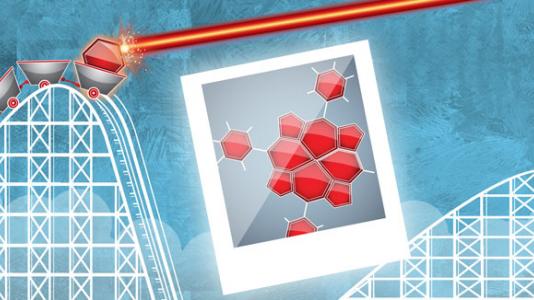Seeing energized light-active molecules proves quick work for Argonne scientists

Trying to take a picture at exactly the moment that the roller coaster reaches its zenith can be difficult because the drop happens so suddenly.
For chemists trying to take pictures of energized molecules, the dilemma is precisely the same, if not trickier. When certain molecules are excited – like a roller coaster poised at the very top of its run – they often stay in their new state for only an instant before “falling” into a lower energy state.
To understand how molecules undergo light-driven chemical transformations, scientists need to be able to follow the atoms and electrons within the energized molecule as it rides on the energy “roller coaster.”
In a recent study, a team of researchers at the U.S. Department of Energy’s (DOE’s) Argonne National Laboratory, Northwestern University, the University of Washington and the Technical University of Denmark used the ultrafast high-intensity pulsed X-rays produced by the Linac Coherent Light Source (LCLS), a DOE Office of Science User Facility at SLAC National Accelerator Laboratory, to take molecular snapshots of these molecules.
By using the LCLS, the researchers were able to capture atomic and electronic arrangements within the molecule that had lifetimes as short as 50 femtoseconds – which is about the amount of time it takes light to travel the width of a human hair.
“We can see changes in these energized molecules which happen incredibly quickly,” said Lin Chen, an Argonne senior chemist and professor of chemistry at Northwestern University who led the research.
Chen and her team looked the structure of a metalloporphyrin, a molecule similar to important building blocks for natural and artificial photosynthesis. Metalloporphyrins are of interest to scientists who seek to convert solar energy into fuel by splitting water to generate hydrogen or converting carbon dioxide into sugars or other types of fuels.
Specifically, the research team examined how the metalloporphyrin changes after it is excited with a laser. They discovered an extremely short-lived “transient state” that lasted only a few hundred femtoseconds before the molecule relaxed into a lower energy state.
“Although we had previously captured the molecular structure of a longer-lived state, the structure of this transient state eluded our detection because its lifetime was too short,” Chen said.
When the laser pulse hits the molecule, an electron from the outer ring moves into the nickel metal center. This creates a charge imbalance, which in turn creates an instability within the whole molecule. In short order, another electron from the nickel migrates back to the outer ring, and the excited electron falls back into the lower open orbital to take its place.
“This first state appears and disappears so quickly, but it’s imperative for the development of things like solar fuels,” Chen said. “Ideally, we want to find ways to make this state last longer to enable the subsequent chemical processes that may lead to catalysis, but just being able to see that it is there in the first place is important.”
The challenge, Chen said, is to prolong the lifetime of the excited state through the design of the metalloporphyrin molecule. “From this study, we gained knowledge of which molecular structural element, such as bond length and planarity of the ring, can influence the excited state property,” Chen said. “With these results we might be able to design a system to allow us to harvest much of the energy in the excited state.”
A paper based on the research, “Ultrafast excited state relaxation of a metalloporphyrin revealed by femtosecond X-ray absorption spectroscopy,” was published in the June 10 online edition of the Journal of the American Chemical Society.
The research was funded by the DOE’s Office of Science and by the National Institute of Health.
Argonne National Laboratory seeks solutions to pressing national problems in science and technology. The nation’s first national laboratory, Argonne conducts leading-edge basic and applied scientific research in virtually every scientific discipline. Argonne researchers work closely with researchers from hundreds of companies, universities, and federal, state and municipal agencies to help them solve their specific problems, advance America’s scientific leadership and prepare the nation for a better future. With employees from more than 60 nations, Argonne is managed by UChicago Argonne, LLC for the U.S. Department of Energy’s Office of Science.
The U.S. Department of Energy’s Office of Science is the single largest supporter of basic research in the physical sciences in the United States and is working to address some of the most pressing challenges of our time. For more information, visit the Office of Science website.